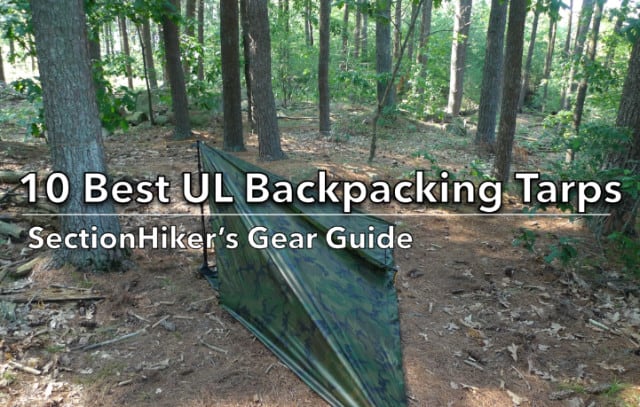
Backpacking tarps are a great camping option if you want to significantly reduce your backpacking gear weight while experiencing a deeper connection to the outdoors, by sleeping under a shelter without walls. Backpacking tarps come in two basic flavors: shaped, catenary cut tarps that have curved sides to reduce weight and flapping in the wind, and square, flat tarps with 90-degree corners which can be pitched in many different configurations but take more skill to use. Ground sleepers usually sleep in bivy sacks under such tarps for insect protection along with a waterproof groundsheet, a sheet of Tyvek, or plastic window wrap.
Here are the 10 best ultralight backpacking tarps we recommend:
| Make / Model | Type | Material | Weight |
|---|---|---|---|
| Hyperlite Mountain Gear Flat Tarp | Flat Tarp | DCF | 8.85 oz / 251 g |
| Zpacks 8.5' x 10' Flat Tarp | Flat Tarp | DCF | 7.1 oz / 201g |
| Gossamer Gear Twinn Tarp | Catenary Cut | Sil/PU Nylon | 9.5 oz / 269g |
| Mountain Laurel Designs Grace Duo | Catenary Cut | DCF | 6.25 oz / 177g |
| Hammock Gear The Traverse Tarp | Flat Tarp | Silpoly | 13.7 oz / 388g |
| Hilleberg Tarp 5 | Catenary Cut | Silnylon | 11.3 oz / 320g |
| Paria Outdoors Sanctuary Sil Tarp Tapered | Catenary Cut | Sil/PU Nylon | 10 oz / 283g |
| Mountain Laurel Designs Trailstar | Catenary Cut | Silnylon, DCF | 15 oz / 425g |
| Slingfin SplitWing UL Tarp | Catenary Cut | Sil/Sil Nylon | 7.9 oz / 224g |
| Warbonnet Mini Fly | Catenary Cut | Silpoly, Silnylon | 13 oz /369g |
1. Hyperlite Mountain Flat Tarp
2. Zpacks 8.5′ x 10′ Flat Tarp
3. Gossamer Gear Twinn Tarp
4. Mountain Laurel Designs Grace Duo Tarp
5. Hammock Gear Traverse Tarp
6. Hilleberg Tarp 5
7. Paria Outdoors Sanctuary Sil Tarp
8. Mountain Laurel Designs Trailstar
9. SlingFin SplitWing UL Tarp
10. Warbonnet MiniFly
Key Considerations
Tarp Types: Flat Tarps vs Catenary Cut Tarps
Flat tarps have 90-degree corners with flat sides and are shaped like squares or rectangles. They can be set up in a wide variety of different pitches that emphasize views, airflow, or weather protection. Catenary cut tarps have curved sides and ridgelines which reduce the amount of fabric required to make them and lowers their weight. But this limits the variety of ways they can be set up, often limiting them to a simple A-frame pitch. Catenary cut tarps are also quieter in the wind because the fabric is stretched more tightly. Some catenary cut tarps are also tapered, meaning one end is wider than the other. This is also a weight-saving measure.
Fabric/Materials
Tarps are available in several different fabrics that convey different properties to them.
- Tarps made with Dyneema DCF are very lightweight and have very little stretch. However, this can limit the number of ways they can be configured and limit their ability to deal with uneven ground or obstructing vegetation. Dyneema DCF tarps do not have to be seam-sealed and they are very waterproof. They are bulky however and take more room to pack in a backpack.
- Tarps made with Siliconized Nylon (silnylon) or Siliconized Polyester (silpoly) usually have to be seam-sealed so they don’t leak in the rain. They make good flat tarps because they have some stretch, which can be useful when pitching them in different patterns.
- Tarps coated with Polyurethane (PU) or Silicone/PU are usually seam taped and don’t need to be seam sealed.
One and Two Person Tarps
Most people prefer using two-person tarps instead of one-person tarps, even when camping solo, because they have more room to spread out their gear out of the rain and close at hand.
Knot Tying and Guylines
Most catenary cut tarps come with integrated line loc tensioners that eliminate the need to tie knots. When it comes to flat tarps, different people have different preferences. On larger square or rectangular tarps, having fixed guylines can add unnecessary weight and clutter, and many people prefer to add guylines only when they set up their tarp. There some knowledge of knots can be helpful or the use of knot-typing devices like Figure 9s.
Insect Protection and Splashback
Most tarp users sleep in bivy sacks or larger bug bivies for protection from insects and other creepy crawlers. Bivy sacks also provide added rain protection from what is known as “splashback”, when rain bounces off the ground along the sides of the tarp, but bounces back under it and gets your gear wet.
- Paria Outdoor Breeze Mesh Bivy
- Katabatic Gear Pinon Bivy
- Mountain Laurel Designs Superlight Bivy
- Borah Gear Ultralight Bivy Sack
Groundsheets
While many bivy sack bottoms are waterproof, it’s convenient to sleep on top of a groundsheet so you can spread your gear out around you at night. Most ultralight backpackers use a sheet of Tyvek, polycryo plastic sheets (sold by Gossamer Gear), plastic window insulation wrap, or even a Dyneema DCF groundsheet, although the latter is quite expensive compared to other alternatives.
Check Out All of SectionHiker's Gear Guides!
- 10 Best Hiking Shoes and Trail Runners
- 10 Best 2-Person Backpacking Tents
- 10 Best 1-Person Backpacking Tents
- 10 Best Backpacking Stoves
- 10 Best Backpacking Water Filters
- 10 Best Lightweight Backpacks
- 10 Best Ultralight Backpacks
- 10 Best Backpacking Sleeping Bags
- 10 Best Ultralight Backpacking Quilts
- 10 Best Lightweight Backpacking Chairs
- 10 Best Backpacking Sleeping Pads
- 10 Best Backpacking Rain Jackets
- 10 Best Hiking Daypacks
- 10 Best Hiking Pants
- 10 Best Trekking Poles
 SectionHiker.com Backpacking Gear Reviews and FAQs
SectionHiker.com Backpacking Gear Reviews and FAQs 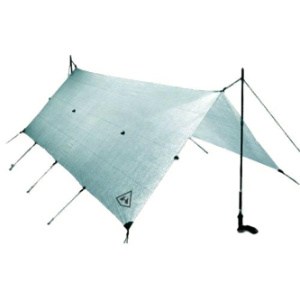
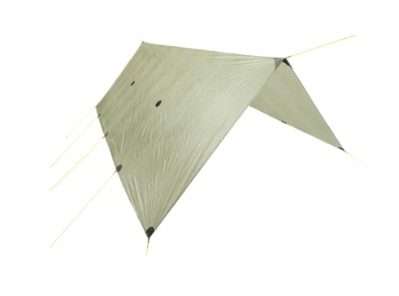
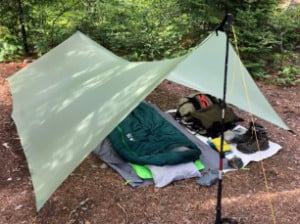
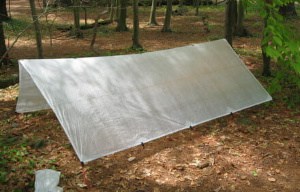
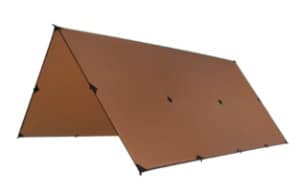
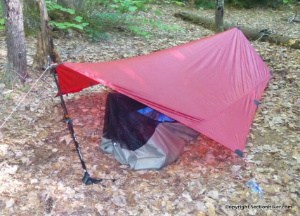
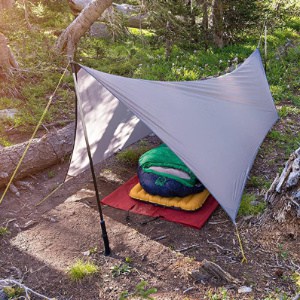
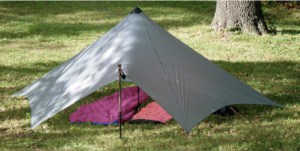
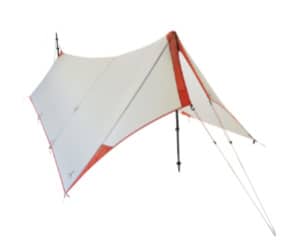
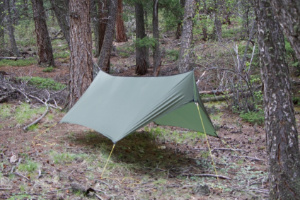
They aren’t quite as light, but the flat tarps from Cooke Custom Sewing are awesome. All the tie-outs you could want, you can choose the colors, and “quad loop” holds a center pole in place. Securing a center pole makes so much more space in a lot of tarp pitches.
Step through the photos to see diagrams of the tieouts, the quad loop, and the weights of the different sizes (8×10 up to 15×15).
https://cookecustomsewing.com/shop/ols/products/1-1oz-silicone-tarp
Here is nice review of a 10 x 10, the same size I have.
https://www.canadianoutdoorequipment.com/expert-advice/coec-equipped/css-silnylon-tundra-tarp.html
Oh, and the stuff sack is actually big enough, you don’t have to do a factory fold to get it to fit!
Always wondered why most good flat tarps don’t have a center tie-out. I ordered mine custom with one and find it most useful for certain situations.
I like to a have at least three along the ridgeline and not just near the edges. They’re essential for suspending bug bivies.
When I hiked the Pemi Loop a couple years ago, I used a poncho/tarp from River Country Products. It was awesome. I’m not the tallest guy, so I can get away with using a recreational hammock and this smaller poncho tarp for protection from the rain. I had it weighing in at 10 oz, and for $10 it was an absolute STEAL!
I just checked and they carry other tarps as well. They might be worth checking out for those of us on a budget.
Tarps are fun too! If you’re of a tinkering sort, you can set up a tarp a hundred different ways. One trip I set my tarp up a different way each night, just for the challenge. Tents these days take no ingenuity. FWIW, I have the Hyperlite 8×10 and use a Katabatic bivy.